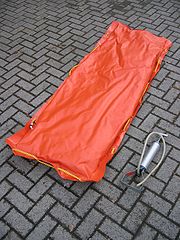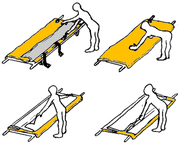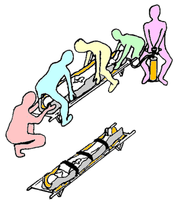
Vacuum mattress
Encyclopedia

Medical device
A medical device is a product which is used for medical purposes in patients, in diagnosis, therapy or surgery . Whereas medicinal products achieve their principal action by pharmacological, metabolic or immunological means. Medical devices act by other means like physical, mechanical, thermal,...
used for the immobilisation of patients, especially in case of a vertebra, pelvis or limb trauma
Physical trauma
Trauma refers to "a body wound or shock produced by sudden physical injury, as from violence or accident." It can also be described as "a physical wound or injury, such as a fracture or blow." Major trauma can result in secondary complications such as circulatory shock, respiratory failure and death...
(especially for femur
Femur
The femur , or thigh bone, is the most proximal bone of the leg in tetrapod vertebrates capable of walking or jumping, such as most land mammals, birds, many reptiles such as lizards, and amphibians such as frogs. In vertebrates with four legs such as dogs and horses, the femur is found only in...
trauma). It is also used for manual transportation of patients for short distances (it replaces the stretcher
Stretcher
A stretcher is a medical device used to carry casualties or an incapacitated person from one place to another. It is a simple type of litter, and still called by that name in some cases....
). It was invented by Loed and Haederlé, who called it "shell" mattress (matelas coquille in French
French language
French is a Romance language spoken as a first language in France, the Romandy region in Switzerland, Wallonia and Brussels in Belgium, Monaco, the regions of Quebec and Acadia in Canada, and by various communities elsewhere. Second-language speakers of French are distributed throughout many parts...
).
It consists of a sealed polymer
Polymer
A polymer is a large molecule composed of repeating structural units. These subunits are typically connected by covalent chemical bonds...
bag (bigger than an adult human body) that encloses small polystyrene
Polystyrene
Polystyrene ) also known as Thermocole, abbreviated following ISO Standard PS, is an aromatic polymer made from the monomer styrene, a liquid hydrocarbon that is manufactured from petroleum by the chemical industry...
balls, with a valve, straps and handles. It is washable and invisible to X-ray
X-ray
X-radiation is a form of electromagnetic radiation. X-rays have a wavelength in the range of 0.01 to 10 nanometers, corresponding to frequencies in the range 30 petahertz to 30 exahertz and energies in the range 120 eV to 120 keV. They are shorter in wavelength than UV rays and longer than gamma...
s.
When the mattress is under pressure, the balls are free and the mattress can be moulded. Usually, the vacuum mattress is put on a stretcher, the patient is put on the mattress (e.g. with a scoop stretcher
Scoop stretcher
The scoop stretcher is a device used specifically for casualty lifting...
), and the sides of the mattress are moulded around the patient. Then, the air is pumped out through the valve and the valve is closed. The atmospheric pressure presses the balls together and the mattress becomes hard and rigid. The straps are then tied to secure the patient.
A sheet is usually put on the vacuum mattress, for three reasons:
- to protect the mattress. The casualty might have broken glass on their clothes or be wearing jewelry that might puncture the mattress,
- to avoid direct contact of the skin with plastic, e.g. for a sweating casualty,
- to help the patient transfer at the emergency room.
Use of the vacuum mattress
The full spine immobilisation (splintSplint (medicine)
A splint is a device used for support or immobilization of limbs or of the spine.It can be used:* By the emergency medical services or by volunteer first responders, to immobilize a fractured limb before the transportation; it is then a temporary immobilization;* By allied health professionals such...
) is performed with:
- a rigid cervical collarCervical collarA cervical collar is an orthopedic medical device used to support a patient's neck and head. It is also used by emergency personnel for victims of traumatic head or neck injuries, and can be used to treat chronic medical conditions....
- a vacuum mattress
- a stretcher under it (the longitudinal stiffness of the mattress alone is not sufficient).
Preparation of the vacuum mattress

Stretcher
A stretcher is a medical device used to carry casualties or an incapacitated person from one place to another. It is a simple type of litter, and still called by that name in some cases....
or possibly on a long spine board
Long spine board
A spinal board, also known as a long spine board , longboard, spineboard, or backboard, is a patient handling device used primarily in pre-hospital trauma care designed to provide rigid support during movement of a patient with suspected spinal or limb injuries...
. The straps are put under the mattress, along its side, so they do not reach the ground. Then, the polystyrene balls are distributed evenly through the mattress by shaking its surface. A section with fewer balls would be less rigid. It is also possible to concentrate the balls in a given point to make this place more rigid. Finally, a sheet is put on the mattress. The sheet is folded so it will be possible to pull it to wrap the casualty into it; the profile has an S-shape.
The team member also checks that the pump (manual or electrical) works in the right direction.
Moulding the mattress

- lifting the casualty and pushing the stretcher under it. This method requires five team members (four lifting and one pushing the stretcher) and should be used when a spine or a pelvis trauma are suspected;
- the casualty is lifted with a scoop stretcherScoop stretcherThe scoop stretcher is a device used specifically for casualty lifting...
. The scoop stretcher is put on the mattress and opened to release the casualty; - the casualty is lifted on a long spine board. The board is put on the mattress and the casualty is lifted (best with four team members) and one team member removes the board.
In all cases, the vacuum valve is up and at the feet of the casualty.
Once the casualty is on the mattress, the sheet is wrapped around him/her and the sides of the mattress are folded against their body. The top of the head must be kept clear (the mattress could retract when pumping out the air and thus compress the spine). The air is pumped until the mattress is rigid, then the valve is closed and the straps are fastened.
When only three team members are available and there is no scoop stretcher, the following procedure can be used:
- the vacuum mattress is put besides the casualty, on a protecting ground sheet, and partially depressed (three manual pumping) to make it more rigid and thinner. A sheet is put on the mattress, closer to the casualty;
- the casualty is put on their side, with a procedure that is similar to the recovery positionRecovery positionThe recovery position refers to one of a series of variations on a lateral recumbent or three-quarters prone position of the body, in to which an unconscious but breathing casualty can be placed as part of first aid treatment.An unconscious person The recovery position refers to one of a series of...
; - the team member at the legs pushes the mattress against the back of the casualty. The ground sheet helps to slide the mattress on the floor;
- the casualty is put on their back, overlapping the side of the mattress;
- the casualty is centred on the mattress; the sheet helps sliding the casualty on the mattress;
- the straps are tied to mould the mattress. The team leader moulds the sides of the head manually;
- the air is pumped;
- a long spine board is placed along the axis of the mattress. Two team members face each other and hold the mattress's handles at the head and at the thighs. They lift a few centimetres, the ground sheet is removed and the board is slid under the mattress to ensure longitudinal rigidity;
- the board can then be lifted (with the mattress on it), and put on the stretcher.
While the lifting methods can induce a flexing of the spine, this rolling method can be hazardous for several reasons: the risk of a torsion of the spine when rolling, the risk when sliding the casualty on the mattress, the risk of anteversion of the hips (and thus of flexing of the spine) due to the weight of the legs when lifting the mattress to slide the board.
Advantages and disadvantages
The vacuum mattress is an alternative to the use of a long spine boardLong spine board
A spinal board, also known as a long spine board , longboard, spineboard, or backboard, is a patient handling device used primarily in pre-hospital trauma care designed to provide rigid support during movement of a patient with suspected spinal or limb injuries...
. Its advantages are:
- it is comfortable;
- it is adapted to all traumas, included spine and femoral traumas;
- the victim feels secured;
- it can be used instead of a stretcher for manual transportation (with the handles, e.g. in stairs) when longitudinal rigidity is not critical, or for short distances with six team members.
Its drawbacks are:
- it is relatively fragile, and becomes useless if only partially inflated (the vacuum requires a perfectly sealed envelope);
External links
- A photographic guide to pre-hospital spinal care (PDF file, 235p, 9 Mb)

